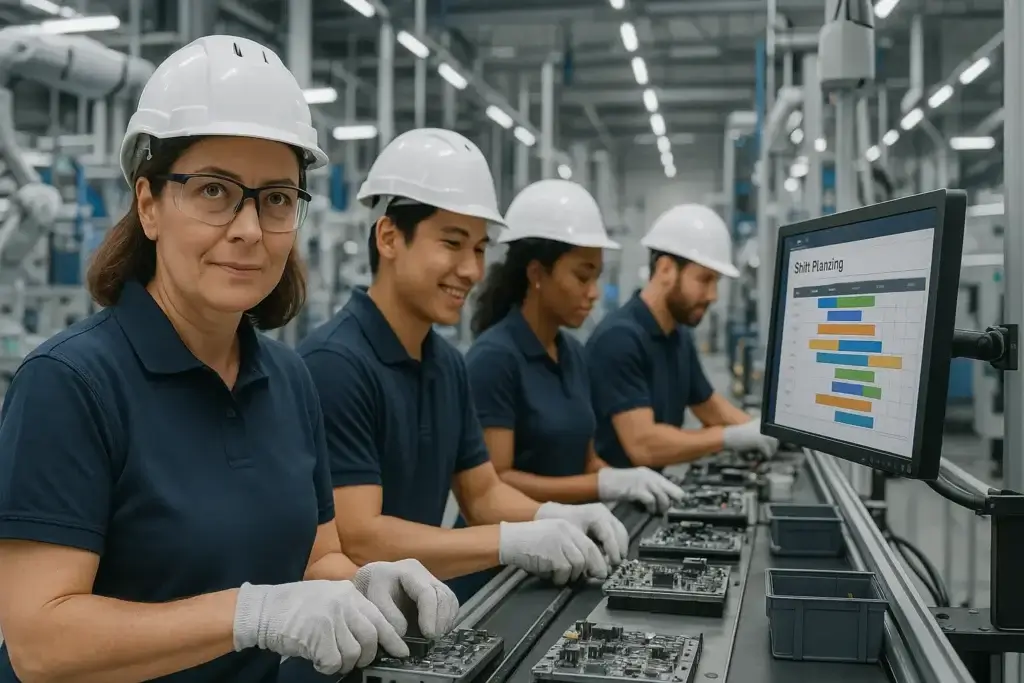Transforming Operations with shift planning for manufacturing plants
The manufacturing sector constantly faces change. With evolving technologies and shifting customer demands, matching workforce schedules with real production needs is a challenge that cannot be ignored. Old-school methods like fixed shifts and routine modifications often miss the mark when production demands fluctuate unexpectedly. It leads to cycles of understaffing that strain production lines, or overstaffing that unnecessarily drives up labor costs. Against this backdrop, a smarter approach is needed. Forecast-driven scheduling, when combined with shift planning for manufacturing plants, offers a future-ready solution that can bridge the gap between resources and demand.This article dives into the idea of forecast-driven shift planning. We will explain how it marks a significant change in workforce scheduling practices by using technology-driven insights. You will find discussions on its core principles, key technological supports, and the myriad benefits that come with this strategy. We also cover real-world examples, challenges you might face, and actionable tips on integrating this approach within current production systems. Manufacturers who make this transition can refine operations, boost employee morale, and trim operational expenses. And with smart features like mobile scheduling and push notifications, the path to efficiency becomes even clearer.
Understanding Forecast-Driven Planning
shift planning for manufacturing plants in action
At its essence, forecast-driven shift planning harnesses the power of data and predictive insights to match workforce schedules with anticipated demand. Moving away from static schedules and gut-based choices, this method continually adjusts schedules using real-time data, historical trends, and refined algorithms. Manufacturers relying on this approach can accurately spot production peaks and dips, thereby fine-tuning their labor allocation effectively.Multiple data sources are woven into this strategy—sales histories, seasonal trends, market dynamics, and even broader economic signals play a part. When historical data hints at a seasonal surge, for instance, the forecast-driven system preps for a larger crew. Similarly, in slower periods, it advises trimming shift sizes so that labor isn’t wasted. Through such precision, shift planning for manufacturing plants isn’t solely about operational efficiency; it also fosters a balanced work atmosphere where employees are neither overloaded nor left underutilized.
Benefits for Manufacturing Plants
This modern approach brings a bundle of benefits that stretch far beyond mere cost-cutting measures. One of the standout advantages is a notable drop in labor costs. By aligning the workforce exactly with anticipated needs, companies can sidestep the pitfalls of excessive overtime and superfluous coverage. Savings here can be funneled into vital areas like capital improvement, R&D, or enhanced training programs.Moreover, scheduling that is guided by forecast-driven insights lifts overall productivity. When shift planning for manufacturing plants is done right, production teams can operate at peak performance. During busy times, an expanded staff helps in meeting targets without sacrificing quality. In less demanding periods, smaller teams eliminate the inefficiencies of idle work hours, ensuring that overall costs stay under control. Incorporating features such as time clocks and shift confirmations further enhances day-to-day operational efficiency.Another key benefit is the boost to employee satisfaction. Traditional shift planning can create last-minute changes and disruptions, prompting stress and burnout. A forecast-driven model brings predictability and balance into scheduling, leading to more regular work routines. This improved consistency supports lower turnover rates and a more dedicated workforce, which in turn uplifts product quality and customer experiences. Additionally, modern tools like self‑service portals empower employees to view and manage their own schedules, fostering transparency and trust within the team.Safety also sees an improvement. When staffing is managed prudently, the dangers that come with fatigue and overwork decrease. As a result, workplace accidents become less frequent, protecting both personnel and productivity.
Overcoming Hurdles with Smart Solutions
Adopting forecast-driven strategies is not without its bumps in the road. One of the trickiest challenges is merging data streams from various sources. Manufacturers often juggle information from production machines, sensors, ERP systems, and broader market trends. Without a solid data management layer, the resulting insights can end up fuzzy or outright wrong.Another hurdle is the need for advanced analytics. For smaller firms, the cost and complexity of the required tech and expertise can seem daunting. Thankfully, today’s market offers scalable, cloud-based analytics platforms that are both affordable and powerful. These modern tools make it easier for organizations of all sizes to embrace shift planning for manufacturing plants.Practical fixes include investing in robust data management systems that can gather, clean, and update data in real time. An emphasis on forecasting accuracy is paramount; only precise data input feeds can support reliable predictions. Equally, equipping managers with targeted training programs helps demystify the data so adjustments can be made on the fly. Many companies now see value in partnering with tech vendors specializing in industrial analytics. Such collaborations smooth the initial implementation phase and ensure the transition is as disruption-free as possible. A phased rollout often works best, letting the algorithms be tuned gradually while minimizing operational disturbances. And with built-in dynamic rescheduling capabilities, the system can adapt effortlessly to changing circumstances.
The Role of Technology
Integrating AI and Machine Learning for Greater Precision
Technological advancements are at the heart of forecast-driven shift planning. Modern systems integrate Artificial Intelligence (AI) and Machine Learning (ML) to process vast amounts of data quickly and efficiently. These technologies sift through production metrics, machine performance logs, and market trends to spot patterns that help decide optimal labor allocations.For example, AI can pick up subtle shifts in production data hinting at an impending surge in activity. Whether it’s due to a new product rollout, a seasonal jump, or sudden market unrest, these algorithms adjust staffing plans ahead of time. Machine learning continuously fine-tunes its predictions by learning from past data. This focused refinement boosts forecasting accuracy while easing the burden on management teams. The natural integration with tools that deliver push notifications keeps managers informed about any sudden changes.AI and ML do more than just predict demand. They also simulate alternative scenarios—what if a machine fails, or if a sudden spike in orders occurs? With these simulations, the system can offer quick reassignments and plan backups that help maintain smooth operations even during unexpected hiccups.
Leveraging Real-Time Data for Agile Operations
Real-time data is a cornerstone of effective forecast-driven planning. In today’s interconnected manufacturing spaces, sensors and IoT devices diligently track production metrics, machine health, environment parameters, and energy use. This continuous influx of data injects fresh insights into the scheduling model, letting it adjust swiftly to any change on the floor.Consider a plant fitted with sensors that monitor machine uptime and performance metrics. When any unit shows early signs of slowdown or overheating, the system can prompt a maintenance alert and tweak labor forecasts. This real-time monitoring forms a dynamic feedback loop that keeps operations nimble. And by incorporating parameters from handheld time clocks and other digital interfaces, management can achieve a granular oversight of daily production trends.There’s also a strong advantage to reacting in real time. Whether production surges unexpectedly or supply challenges arise, the system recalibrates quickly. Such agility minimizes downtime and ensures the facility continues running smoothly even in the face of sudden disturbances.
Choosing Software That Fits Your Needs
With technology evolving so quickly, finding the right software to power forecast-driven planning is key. The right platform should connect easily with existing ERP, MES, and HR systems to ensure data flows uniformly across all departments. This integration is central to making accurate predictions and streamlining operations.The chosen software must also boast strong analytical tools capable of handling complex datasets effortlessly. A user-friendly interface is a must for ensuring that everyone—from floor managers to number crunchers—can use the system without lengthy training. Custom dashboards, real-time reports, and tools for monitoring dynamic rescheduling make the software even more attractive and practical. Incorporating elements like mobile scheduling keeps everyone connected wherever they are.Another critical factor is the vendor’s commitment to support and upgrades. Given the fast-moving nature of manufacturing, it’s essential that the software continues to evolve. A dedicated vendor can tailor solutions to your specific processes, ensuring that shift planning for manufacturing plants remains not only efficient but also innovative. Sustained updates and technical support play a crucial role in smoothing out any bumps along the way.
Implementing Forecast-Driven Planning
Creating a Robust Strategic Roadmap
Launching a forecast-driven system starts with crafting a detailed strategic plan. This plan should set clear objectives, define the expected results, and outline time frames and resource allocation. A solid roadmap lays the foundation for a smooth transition, lining up everyone from production to IT on the same page.It’s essential to involve different teams from across the organization—from production and HR to finance and IT. When multiple perspectives converge, the strategy becomes richer and more realistic. For example, the production team may flag periods of heightened activity while HR can advise on possible scheduling hurdles. This diverse input ensures that any shift planning for manufacturing plants strategy reflects the complex reality of plant operations.Embedding a pilot phase into your plan can also prove invaluable. Running a small-scale test in one section of your facility lets you gather insights and gauge the system’s performance under controlled conditions. Feedback gathered from the pilot can pave the way for fine-tuning before a full rollout. This step-by-step implementation helps minimize risks and adapt features like shift confirmations and dynamic rescheduling gradually, making the transition less disruptive.
Effective Training and Ongoing Support
No matter how brilliant the system, success depends largely on people. Training is a cornerstone of any new initiative, and employees at all levels must grasp how to interpret data and use the new tools effectively. Regular training sessions should cover everything from the basics of predictive analytics to the finer points of software navigation. Incorporating the use of self‑service portals into these programs gives staff added empowerment over their schedules, fostering a deeper engagement with the process.A robust support structure is equally important. Whether through an internal helpdesk or a partnership with your technology vendor, quick resolutions to any technical or operational issues can significantly ease the implementation curve. Continuous learning via refreshers and team workshops can also build confidence among staff. Management might consider assigning a dedicated transition team to act as a bridge between departments, ensuring that all barriers are swiftly addressed.As companies advance into this new realm, maintaining open lines of communication about scheduling changes and system updates becomes critical. Notifications—whether delivered as push notifications or on mobile scheduling apps—can keep everyone on the same page, making the journey towards smarter shift planning for manufacturing plants even smoother.
Reviewing and Refining for Long-Term Success
Even the best systems need adjustments. Continuous review is essential to ensure that forecast-driven planning delivers its promised benefits. Regular performance checks comparing forecasted outputs against actual results can highlight areas of improvement. This iterative approach helps fine-tune algorithms and ultimately boosts forecasting accuracy.Creating a feedback loop where managers and staff share their day-to-day observations makes a huge difference. These practical insights often spark system tweaks that enhance performance. Over time, this cycle of review and update turns the planning tool into a living system that adapts to new challenges and production realities. The use of dynamic rescheduling ensures that even unexpected shifts in demand are met with a rapid and measured response.For an unbiased view, consider periodic external audits alongside internal reviews. Third-party experts can provide clear assessments that might uncover overlooked issues and suggest strategic adjustments. This cycle promotes a culture of continuous improvement and helps secure long-term performance gains across your manufacturing operations.
Conclusion
Shifting to a forecast-driven model is more than just a trend—it’s a strategic evolution for today’s manufacturing operations. By tapping into predictive analytics, real-time data, and advanced technology, companies can align their workforce with true production demands through smart shift planning for manufacturing plants. The outcomes are impressive: cost savings from reduced overtime, a balanced workforce that cheers better product quality, and a safer workplace with fewer accidents.The benefits are rich and varied. Enhanced productivity, streamlined operations bolstered by mobile scheduling and time clocks, and improved employee morale stemming from clear shift confirmations, all come together to reshape plant dynamics. As AI, ML, and IoT increasingly inform decision-making processes, forecasting accuracy continues to improve, assuring that every change in production is met with a calculated response.Introducing this innovative system requires thoughtful planning, regular training, and constant assessment. However, the rewards far surpass the initial hurdles. Manufacturers who invest in shift planning for manufacturing plants not only streamline their current processes but also set the stage for future success. The journey to smarter, more flexible operations has never been more accessible.Embrace the change—invest in the right software, nurture your team with in-depth training, and maintain a culture of continuous learning and responsiveness. With the combined power of cutting-edge analytics and a proactive approach, you can turn your production facility into a powerhouse that meets modern challenges head-on. Start now, and be at the forefront of innovation in the manufacturing world.
Daria Olieshko
A personal blog created for those who are looking for proven practices.


 English
English  Español
Español  Português
Português  Deutsch
Deutsch  Français
Français  Italiano
Italiano  日本語
日本語  中文
中文  हिन्दी
हिन्दी  עברית
עברית  العربية
العربية  한국어
한국어  Nederlands
Nederlands  Polski
Polski  Türkçe
Türkçe  Українська
Українська  Русский
Русский  Magyar
Magyar  Română
Română  Čeština
Čeština  Български
Български  Ελληνικά
Ελληνικά  Svenska
Svenska  Dansk
Dansk  Norsk
Norsk  Suomi
Suomi  Bahasa
Bahasa  Tiếng Việt
Tiếng Việt  Tagalog
Tagalog  ไทย
ไทย  Latviešu
Latviešu  Lietuvių
Lietuvių  Eesti
Eesti  Slovenčina
Slovenčina  Slovenščina
Slovenščina  Hrvatski
Hrvatski  Македонски
Македонски  Қазақ
Қазақ  Azərbaycan
Azərbaycan  Afrikaans
Afrikaans  বাংলা
বাংলা 
